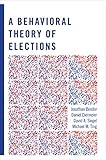A Behavioral Theory of Elections / Jonathan Bendor, Michael Ting, David A. Siegel, Daniel Diermeier.
Material type: TextPublisher: Princeton, NJ : Princeton University Press, [2011]Copyright date: ©2011Edition: Course BookDescription: 1 online resource (264 p.) : 30 line illusContent type:
TextPublisher: Princeton, NJ : Princeton University Press, [2011]Copyright date: ©2011Edition: Course BookDescription: 1 online resource (264 p.) : 30 line illusContent type: - 9780691135076
- 9781400836802
- Behaviorism (Political science)
- Voting -- Psychological aspects
- POLITICAL SCIENCE / Political Process / Campaigns & Elections
- Condorcet winner
- Downsian party competition
- Duverger's Law
- Markov chain
- Pareto dominance
- adaptation
- aspiration-based adaptation
- aspiration-based adaptive rule
- aspiration-based adjustment
- aspirations
- bandwagon effect
- behavior
- behavioral theory
- bounded rationality
- candidates
- computational model
- decision making
- election voting
- elections
- equilibrium behavior
- faction size
- framing
- game-theoretic model
- hedonics
- heuristics
- incumbent
- majority faction
- multiparty elections
- parties
- party affiliation
- party competition
- payoffs
- platforms
- political parties
- politicians
- population size
- propensity
- rational choice theory
- rational choice
- rationality
- retrospective voting
- satisficing
- search behavior
- stochastic process
- turnout
- two-party elections
- voter choice
- voter coordination
- voter participation
- voter turnout
- voters
- 324.90019 23
- JF1001 .B414 2017
- online - DeGruyter
- Issued also in print.
| Item type | Current library | Call number | URL | Status | Notes | Barcode | |
|---|---|---|---|---|---|---|---|
 eBook
eBook
|
Biblioteca "Angelicum" Pont. Univ. S.Tommaso d'Aquino Nuvola online | online - DeGruyter (Browse shelf(Opens below)) | Online access | Not for loan (Accesso limitato) | Accesso per gli utenti autorizzati / Access for authorized users | (dgr)9781400836802 |
Frontmatter -- Contents -- Acknowledgments -- Chapter One. Bounded Rationality and Elections -- Chapter Two. Aspiration-based Adaptive Rules -- Chapter Three. Party Competition -- Chapter Four. Turnout -- Chapter Five. Voter Choice -- Chapter Six. An Integrated Model of Two-Party Elections -- Chapter Seven. Elections with Multiple Parties -- Chapter Eight. Conclusions: Bounded Rationality and Elections -- Appendix A. Proofs -- Appendix B. The Computational Model -- Bibliography -- Index
restricted access online access with authorization star
http://purl.org/coar/access_right/c_16ec
Most theories of elections assume that voters and political actors are fully rational. While these formulations produce many insights, they also generate anomalies--most famously, about turnout. The rise of behavioral economics has posed new challenges to the premise of rationality. This groundbreaking book provides a behavioral theory of elections based on the notion that all actors--politicians as well as voters--are only boundedly rational. The theory posits learning via trial and error: actions that surpass an actor's aspiration level are more likely to be used in the future, while those that fall short are less likely to be tried later. Based on this idea of adaptation, the authors construct formal models of party competition, turnout, and voters' choices of candidates. These models predict substantial turnout levels, voters sorting into parties, and winning parties adopting centrist platforms. In multiparty elections, voters are able to coordinate vote choices on majority-preferred candidates, while all candidates garner significant vote shares. Overall, the behavioral theory and its models produce macroimplications consistent with the data on elections, and they use plausible microassumptions about the cognitive capacities of politicians and voters. A computational model accompanies the book and can be used as a tool for further research.
Issued also in print.
Mode of access: Internet via World Wide Web.
In English.
Description based on online resource; title from PDF title page (publisher's Web site, viewed 29. Jul 2021)


